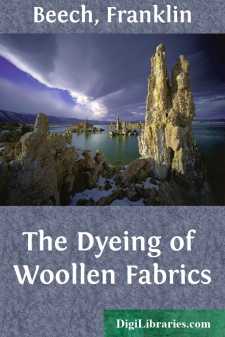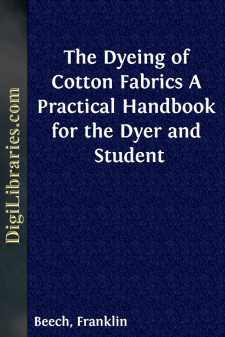Categories
- Antiques & Collectibles 13
- Architecture 36
- Art 48
- Bibles 22
- Biography & Autobiography 813
- Body, Mind & Spirit 142
- Business & Economics 28
- Children's Books 17
- Children's Fiction 14
- Computers 4
- Cooking 94
- Crafts & Hobbies 4
- Drama 346
- Education 46
- Family & Relationships 57
- Fiction 11829
- Games 19
- Gardening 17
- Health & Fitness 34
- History 1377
- House & Home 1
- Humor 147
- Juvenile Fiction 1873
- Juvenile Nonfiction 202
- Language Arts & Disciplines 88
- Law 16
- Literary Collections 686
- Literary Criticism 179
- Mathematics 13
- Medical 41
- Music 40
- Nature 179
- Non-Classifiable 1768
- Performing Arts 7
- Periodicals 1453
- Philosophy 64
- Photography 2
- Poetry 896
- Political Science 203
- Psychology 42
- Reference 154
- Religion 513
- Science 126
- Self-Help 84
- Social Science 81
- Sports & Recreation 34
- Study Aids 3
- Technology & Engineering 59
- Transportation 23
- Travel 463
- True Crime 29
The Dyeing of Woollen Fabrics
by: Franklin Beech
Categories:
Description:
Excerpt
CHAPTER I.
THE WOOL FIBRE.
Wool is one of the most important textile fibres used in the manufacture of woven fabrics of all kinds. It belongs to the group of animal fibres of which three kinds are met with in nature, and used in the manufacture of textile fibres; two of these are derived from quadruped animals, such as the sheep, goat, etc., while the third class comprises the products of certain insects, e.g., silk.
The skin of all animals is covered with more or less of a fibrous coat, which serves as a sort of protecting coat from the weather to the skin underneath. Two different kinds of fibres are found on animals; one is a stiff kind of fibre varying in length very much and called hairy fibres, these sometimes grow to a great length. The other class of animal fibres are the woolly fibres, short, elastic and soft; they are the most esteemed for the manufacture of textile fabrics, it is only when the hairy fibres are long that they are serviceable for this particular purpose. There is a slight difference in the structure of the two kinds of fibre, woolly fibres having a more scaly structure than hairy fibres; the latter also differ in being more cylindrical in form.
Wool.--By far the most important of the animal fibres is wool, the fibre of the domestic sheep. Other animals, the llama or alpaca, the Angora and Cashmere goats also yield fibres of a similar character, which are imported under the name of wools. There are many varieties of wools Which are yielded by the various breeds of sheep, but they may be roughly divided into two kinds, according to the length of "staple," as it is called. In the long-stapled wools the fibres average from 7-1/2 to 9-1/2 inches in length, while the short-stapled wools vary from 1 to 2 inches long. The diameter varies very considerably from 0.00033 to 0.0018 of an inch.
Two varieties of thread are spun from wool, one is known as "worsted," the other as "woollen" yarns; from these yarns two kinds of cloths are woven, distinguished as worsted and woollen cloths; the former are in general not subjected to any milling or felting process, while the latter invariably are.
Physical Properties.--When seen under the microscope the wool fibres show a rod-like structure covered with broad scales, the edges of which project from the body of the fibre, and all point in one direction.
Fig. 1 shows typical wool fibres as viewed under the microscope; the sketch shows very well the scales.
The shape of the scales varies in different breeds of wool. The outer scales enclose inner medullary cells, which often contain pigment matter. A transversed section of the wool fibre shows the presence of a large number of cells. Sometimes wool fibres are occasionally met with which have a peculiar white horny appearance; these do not felt or dye well. They are known as "kempy" fibres. See figure 2. The microscope shows that they are largely devoid of structure, and are formed of very horny, impenetrable tissue, which is difficult to treat in the milling or dyeing process.
...


